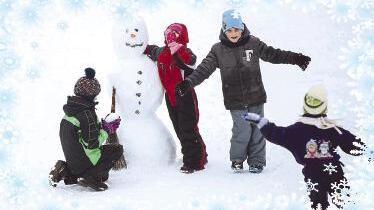December has already delighted us with an exceptional amount of snow this year. It is currently melting again at low altitudes, but according to meteorologists there is a chance of a white Christmas. According to current forecasts, it will get significantly colder again in the days before December 24th. It’s not just winter sports enthusiasts who find the white splendor fascinating; researchers are also interested in the icy crystals, none of which are alike. Here are surprising scientific facts about snow.
No snow without dirt: For the formation of a white flake, so-called aerosols are needed in the air. To put it simply, these are tiny particles of dirt and dust. If it is cold and humid enough, water molecules freeze around these crystallization nuclei.
This is how snow is made: Snowflakes are formed directly from water vapor in the clouds. They skip the liquid state, so to speak. The flakes form their typical shape – six perfectly symmetrical arms – as they fall to the ground and cross different temperature and humidity zones.
It needs dust or pollen: Without so-called crystallization nuclei, snowflakes do not form in the clouds. These could be dust or pollen particles, for example. The drops freeze on these, while at the same time the air around the particles and drops also freezes.
Every flake is different: To date, no two flakes have been discovered that looked completely identical. Researchers have calculated that an ice crystal with a diameter of one millimeter is made up of around 100 trillion water molecules. The probability that all molecules in two flakes will be in the same place is low – although not entirely impossible. It has been proven that they form a variety of shapes. They always only have six corners or six rays.
Variable weight: New snow consists of 90 percent air, as physicist Henning Löwe, head of the “Snow Physics” team at the WSL Institute for Snow and Avalanche Research SLF in Davos, explains: One cubic meter of fresh snow weighs around 100 kilograms. At the end of the season, a cubic meter of snow can weigh 400 to 500 kilograms, and even 600 kilograms on the slopes or in an avalanche deposit.
What’s behind it? The flakes have a complex shape. When they fall on each other, they do not compact immediately. That only happens over time. In a blanket of snow, some crystals absorb water vapor while others release it. The flakes and the ice crystals grow together. A porous structure is created, similar to a sponge, which becomes compressed over time.
Why is snow slippery so you can ski on it? This has to do with the water molecules. The lower the temperature, the slower they become. When water freezes, the tiny particles become almost immobile. But at the very outside of the ice layer, the molecules remain mobile, like a liquid. In reality, when you ski and ice skate, you glide along a thin film of water.
Snow food Doesn’t necessarily have to cause a stomach ache like many people think. Snow, like rainwater, is contaminated with pollutants from the air. Eating a handful of snow once is not dangerous to your health.
Let it snow
Song by Eduard Ebel
Let it snow,
the lake lies still and rigid,
The forest shines like Christmas:
Rejoice, Christ child is coming soon.
It’s warm in the hearts,
sorrow and harm are silent,
Life’s worries fade away:
Rejoice, Christ child is coming soon.
Soon it will be holy night;
Choir of angels awakens;
Just listen, how sweet it sounds:
Rejoice, Christ child is coming soon.
background
“The snow quietly trickles down” is one of the most famous Christmas carols in the German language. It was written by the Protestant pastor Eduard Ebel (1839–1905) in 1895 in Graudenz (Poland) and published under the title “Christmas Greetings” in Ebel’s volume “Collected Poems”. The composition of the melody is also often attributed to Ebel, although there is no clear evidence that it came from him.
Furthermore, Ebel’s own publication contains only the text. There are speculations that the melody comes from an old folk tune that Ebel may have adopted for his song. The melody could also have been based on a musette (1792) by Daniel Gottlob Türk (1750–1813), as others suspect. However, the two melodies are only similar in the first bar and a half.
My themes
For your saved topics were
new articles found.

info By clicking on the icon you can add the keyword to your topics.
info
By clicking on the icon you open your “my topics” page. They have of 15 keywords saved and would have to remove keywords.
info By clicking on the icon you can remove the keyword from your topics.
Add the topic to your topics.
Source: Nachrichten




